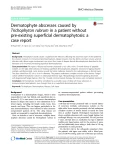Dermatophyte abscesses caused by Trichophyton rubrum in a patient without pre-existing superficial dermatophytosis: a case report
Background:
Trichophyton usually causes a superficial skin infection, affecting the outermost layer of the epidermis, the stratum corneum. In immunocompromised patients, deeper invasion into the dermis and even severe systemic infection with distant organ involvement can occur. Most cases of deeper dermal dermatophytosis described in the literature so far involved pre-existing superficial dermatophytosis.
Case presentation:
We report a 68-year-old woman presented to our clinic with a 3-month history of palpable nodules on the right ankle without pre-existing superficial dermatophytosis. Magnetic resonance imaging showed multiple, well-demarcated, cystic lesions around the lateral malleolus, located in the subcutaneous or dermal layers. The sizes varied from 0.5 cm to 4 cm in diameter. The patient underwent complete excision of the lesions. Fungal culture yielded Trichophyton rubrum on Sabouraud dextrose agar. Histopathology showed organizing abscesses with degenerated fungal hyphae. After the 12-week oral itraconazole therapy, the lesions were completely resolved.
Conclusion:
Dermatophytes should be considered as a possible cause of deep soft tissue abscesses in immunocompromised patients, even though there is no superficial dermatophytosis lesion.
Keywords:
Trichophyton, Dermatophyte, Abscess, Soft tissue
Autoři:
Si-Hyun Kim 1; Ik Hyun Jo 1; Jun Kang 2; Sun Young Joo 3; Jung-Hyun Choi 1*
Působiště autorů:
Division of Infectious Diseases, Department of Internal Medicine, College of Medicine, The Catholic University of Korea, Incheon St. Mary’s Hospital, 56 Dongsu-ro, Bupyeong-gu, Incheon 40 -7 0, Republic of Korea.
1; Department of Pathology, College of Medicine, The Catholic University of Korea, Incheon St. Mary’s hospital, Incheon, Republic of Korea.
2; Department of Orthopedic Surgery, College of Medicine, The Catholic University of Korea, Incheon St. Mary’s Hospital, Incheon, Republic of Korea.
3
Vyšlo v časopise:
BMC Infectious diseases 2016, 16:298
Kategorie:
Case report
prolekare.web.journal.doi_sk:
https://doi.org/10.1186/s12879-016-1631-y
© 2016 The Author(s).
Open Access This article is distributed under the terms of the Creative Commons Attribution 4.0 International License (http://creativecommons.org/licenses/by/4.0/), which permits unrestricted use, distribution, and reproduction in any medium, provided you give appropriate credit to the original author(s) and the source, provide a link to the Creative Commons license, and indicate if changes were made. The Creative Commons Public Domain Dedication waiver (http://creativecommons.org/publicdomain/zero/1.0/) applies to the data made available in this article, unless otherwise stated.
The electronic version of this article is the complete one and can be found online at: http://bmcinfectdis.biomedcentral.com/articles/10.1186/s12879-016-1631-y
Souhrn
Background:
Trichophyton usually causes a superficial skin infection, affecting the outermost layer of the epidermis, the stratum corneum. In immunocompromised patients, deeper invasion into the dermis and even severe systemic infection with distant organ involvement can occur. Most cases of deeper dermal dermatophytosis described in the literature so far involved pre-existing superficial dermatophytosis.
Case presentation:
We report a 68-year-old woman presented to our clinic with a 3-month history of palpable nodules on the right ankle without pre-existing superficial dermatophytosis. Magnetic resonance imaging showed multiple, well-demarcated, cystic lesions around the lateral malleolus, located in the subcutaneous or dermal layers. The sizes varied from 0.5 cm to 4 cm in diameter. The patient underwent complete excision of the lesions. Fungal culture yielded Trichophyton rubrum on Sabouraud dextrose agar. Histopathology showed organizing abscesses with degenerated fungal hyphae. After the 12-week oral itraconazole therapy, the lesions were completely resolved.
Conclusion:
Dermatophytes should be considered as a possible cause of deep soft tissue abscesses in immunocompromised patients, even though there is no superficial dermatophytosis lesion.
Keywords:
Trichophyton, Dermatophyte, Abscess, Soft tissue
Zdroje
1. Havlickova B, Czaika VA, Friedrich M. Epidemiological trends in skin mycoses worldwide. Mycoses. 2008;51 Suppl 4:2–15.
2. Seebacher C, Bouchara JP, Mignon B. Updates on the epidemiology of dermatophyte infections. Mycopathologia. 2008;166(5–6):335–52.
3. Dan P, Rawi R, Hanna S, Reuven B. Invasive cutaneous Trichophyton shoenleinii infection in an immunosuppressed patient. Int J Dermatol. 2011;50(10):1266–9.
4. Seckin D, Arikan S, Haberal M. Deep dermatophytosis caused by Trichophyton rubrum with concomitant disseminated nocardiosis in a renal transplant recipient. J Am Acad Dermatol. 2004;51(5):S173–176.
5. Inaoki M, Nishijima C, Miyake M, Asaka T, Hasegawa Y, Anzawa K, Mochizuki T. Case of dermatophyte abscess caused by Trichophyton rubrum: a case report and review of the literature. Mycoses. 2015;58(5):318–23.
6. Vena GA, Chieco P, Posa F, Garofalo A, Bosco A, Cassano N. Epidemiology of dermatophytoses: retrospective analysis from 2005 to 2010 and comparison with previous data from 1975. New Microbiol. 2012;35(2):207–13.
7. Lee WJ, Kim SL, Jang YH, Lee SJ, Kim Do W, Bang YJ, Jun JB. Increasing prevalence of Trichophyton rubrum identified through an analysis of 115,846 cases over the last 37 years. J Korean Med Sci. 2015;30(5):639–43.
8. Lillis JV, Dawson ES, Chang R, White Jr CR. Disseminated dermal Trichophyton rubrum infection - an expression of dermatophyte dimorphism? J Cutan Pathol. 2010;37(11):1168–9.
9. Warycha MA, Leger M, Tzu J, Kamino H, Stein J. Deep dermatophytosis caused by Trichophyton rubrum. Dermatol Online J. 2011;17(10):21.
10. Allen DE, Snyderman R, Meadows L, Pinnell SR. Generalized microsporum audoninii infection and depressed cellular immunity associated with a missing plasma factor required for lymphocyte blastogenesis. Am J Med. 1977;63(6):991–1000.
11. Cheikhrouhou F, Makni F, Masmoudi A, Sellami A, Turki H, Ayadi A. A fatal case of dermatomycoses with retropharyngeal abscess. Ann Dermatol Venereol. 2010;137(3):208–11.
12. Colwell AS, Kwaan MR, Orgill DP. Dermatophytic pseudomycetoma of the scalp. Plast Reconstr Surg. 2004;113(3):1072–3.
Štítky
Infekčné lekárstvoČlánok vyšiel v časopise
BMC Infectious diseases

2016 Číslo 298
- Očkování proti virové hemoragické horečce Ebola experimentální vakcínou rVSVDG-ZEBOV-GP
- Koronavirus hýbe světem: Víte jak se chránit a jak postupovat v případě podezření?
Najčítanejšie v tomto čísle
